Conversion rate optimization strategy is a systematic and structured approach to improving the performance of your website and app in a way that helps your target audience to take the next action in the user journey. It’s grounded on insights derived from analytics and user feedback. It involves understanding how users move through your site, what actions they take, and what’s stopping them from completing your goals.
CRO is not about increasing traffic or developing more content; it’s about making the most of the traffic you already have. In other words, it’s about turning more of your website visitors into customers ultimately increasing the ROI.
In a world where digital marketing is increasingly competitive, optimizing your conversion rate can give you a significant edge.
This article will provide you with everything you need to ensure high ROI through continuous improvement with a Conversion Rate Optimization Strategy for Mobile & Website:
- Understand why most businesses fail to build an ROI-Driven CRO Strategy
- How continuous ROI Improvement relies on a Conversion Rate Optimization (CRO) Strategy.
- Discover the newest Conversion Rate Optimization Techniques that most businesses missed out on.
- Find out how to create your own CRO Strategy for ongoing success.
Why do most businesses fail to build a ROI-Driven CRO Strategy?
As a Conversion Rate Optimization (CRO) Specialist, understanding why businesses often fail to build an ROI-driven CRO strategy is crucial. There are several key factors contributing to these challenges:

-
Focusing Narrowly on Conversions, Neglecting ROI
Many businesses approach CRO with a narrow focus, concentrating solely on increasing conversions without considering the broader impact on ROI. This approach overlooks the fact that not all conversions contribute equally to a business’s bottom line.
Effective CRO strategies should prioritize changes that offer the most significant potential for revenue growth and profitability, rather than just boosting conversion rates in isolation.
-
Absence of Data-Driven Approach
A common pitfall is not grounding CRO strategies in solid data. Decisions based on assumptions, trends, or superficial analyses can lead to misguided efforts that don’t effectively address the underlying factors affecting conversions and ROI.
A data-driven approach, which includes a thorough analysis of user behaviour, conversion pathways, and customer feedback, is essential for identifying the most impactful optimization opportunities.
-
Lack of Industry-Specific Expertise
Effective CRO strategies demand a deep understanding of the unique dynamics of each industry. A generalized approach can overlook crucial insights, as different sectors have distinct conversion drivers and ROI metrics.
For example, publishers focus on return on Ad Spend, while eCommerce prioritizes the checkout process. Recognizing these nuances is vital for a CRO specialist to develop tailored strategies that truly enhance ROI.
-
Failing to Adapt to Modern CRO Tools and Techniques
The digital landscape is continuously evolving, with new tools, technologies, and methodologies emerging regularly. Failing to stay updated with these advancements can leave a CRO strategy outdated and less effective. Modern tools can provide more comprehensive data, automate complex analyses, and offer advanced testing capabilities, which are essential for a robust, ROI-driven CRO strategy.
What Makes a Comprehensive CRO Strategy?
A well-structured CRO Strategy is more than just a one-off effort to boost conversions. It’s an ongoing process that involves regular testing and optimization to continuously improve your website conversion rate and mobile conversion rate. It’s about creating a culture of continuous improvement, where every decision is data-driven and every action is measured and analyzed.
A well-implemented website & mobile conversion rate optimization strategy, can give you a deep understanding of your audience and their behaviour. It can reveal insights about what works and what doesn’t on your website. And most importantly, it can significantly increase your conversion rate and your bottom line.
A comprehensive CRO strategy doesn’t just focus on one aspect of your website. It looks at everything from your website design and content, to your user journey and checkout process. This holistic approach ensures that every part of your website is optimized for conversions.
A well-structured CRO Process – CRO Specialist – Industry Expertise- CRO Techniques – below is an example
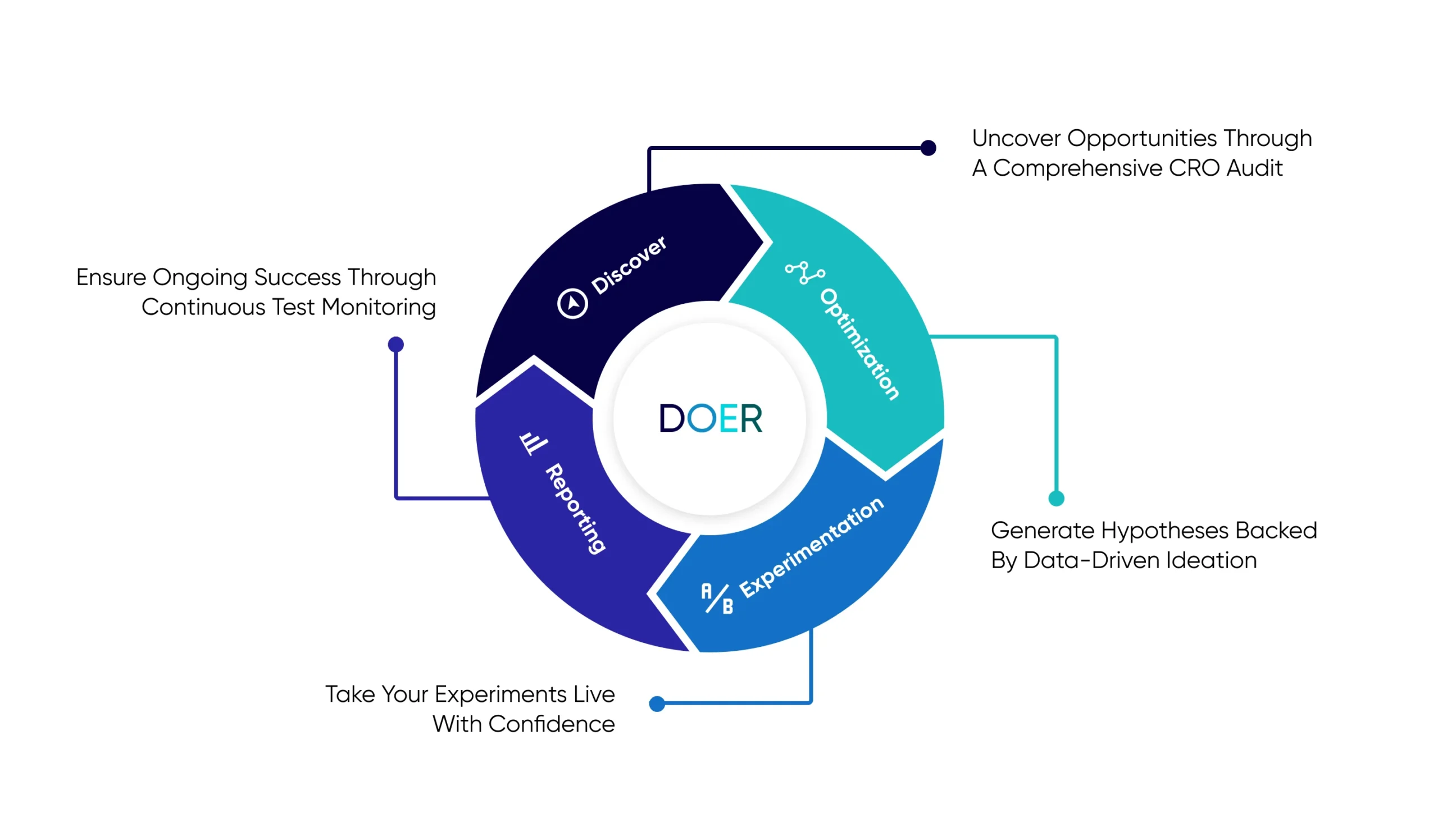
Constructing a Data-Driven CRO Strategy based on the DOER Framework will ensure high ROI value from your CRO efforts
The DEOR Model or Framework followed by Tatvic
Stage 1: Discovery –
This phase is about conducting a thorough CRO audit. It involves an in-depth analysis of the website or application to identify areas that need improvement. This could include quantitat
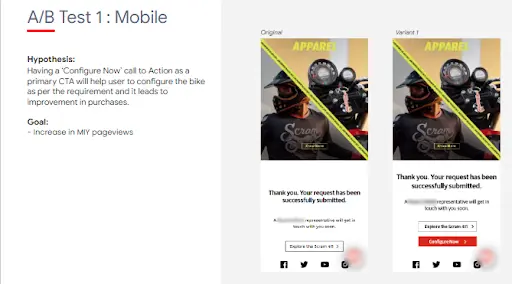
ive and qualitative research, studying user behaviour, analyzing traffic patterns, and understanding pain points in the user journey. The goal is to gather as much relevant data and insights as possible to inform the optimization strategy.
-
Comprehensive CRO Audit
Conducting a CRO audit involves examining how efficiently your website converts visitors into customers. It focuses on elements like user experience, navigation, and design to identify areas needing improvement.
-
Conversion Funnel Analysis
Funnel analysis involves tracking the steps users take on your website leading to a conversion. By analyzing the conversion funnel, you can identify drop-off points and optimize each stage to improve the overall conversion rate. This quantitative data helps pinpoint specific areas for improvement.
-
Average Revenue per User (ARPU):
ARPU is a key metric that quantifies the average amount of revenue generated by each user. By calculating ARPU, you can assess the effectiveness of your marketing and sales strategies. Tracking changes in ARPU over time helps measure the impact of optimizations on revenue generation.
-
Average Session Duration:
Average session duration provides insights into how long users typically spend on your website. A longer session duration may indicate engaged and interested users, while a shorter duration could suggest a lack of engagement or difficulty finding relevant content. Analyzing session duration helps optimize content and user experience.
Stage 2: Optimization –
Develop a tailored action plan and prioritize experiments based on the research gathered in the discovery phase.
Not all potential improvements can be implemented at once, so it’s important to focus on the changes that are expected to have the most significant impact on conversion rates.
-
Align with Business Goals
Make sure that every action, hypothesis, prototype, and experiment directly contributes to your overarching business objectives. This means understanding how each step impacts revenue, cost savings, customer satisfaction, or other key performance indicators (KPIs) relevant to your business.
Giving you an example The Wire, they had approached the team of CRO specialists at Tatvic to increase the number of subscribers who will eventually give monetary support as the Wire is an independent journalist and doesn’t rely on external funds.

-
Data-Driven Decision Making
Use data analytics to inform your hypotheses and action plans. Analyze historical data to identify trends and insights that can guide your decision-making process. Ensure that your ideation process is rooted in tangible data, which can lead to more predictable outcomes and better ROI.
-
Prototype with Purpose
When creating prototypes, focus on features or changes that are most likely to drive ROI. Use prototypes to test specific hypotheses about what will improve key metrics. This approach can help minimize resource expenditure and concentrate efforts on high-impact areas.
For instance, when Fullteron approached Tatvic to improve the number of clicks on the “Apply Loan” CTA, the CRO specialist came up with the hypothesis of placing the USPs below the “Apply for Loan” section this built instant trust among the visitors and they observed a significant uplift in the click rate on “Apply for Loan” button
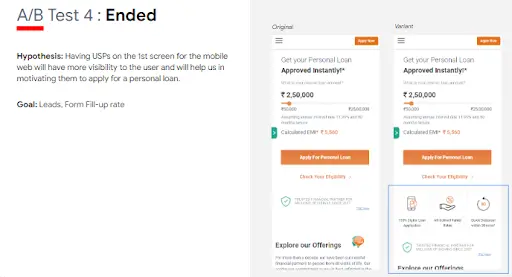
Stage 3: Experimentation and Reporting –
Launch experiments with confidence. These might include A/B testing, multivariate testing, or other forms of user testing. The idea is to test different versions of web pages, user flows, or elements to see which performs better in terms of conversion. This phase is characterized by a trial-and-error approach, but it’s a structured process where each experiment is designed to provide meaningful data.
-
Measure and Analyze Experiment Results
After conducting experiments, thoroughly analyze the results. Look not just at whether an experiment was successful, but also at how it impacted ROI. This might involve measuring changes in sales, customer engagement, cost savings, etc.
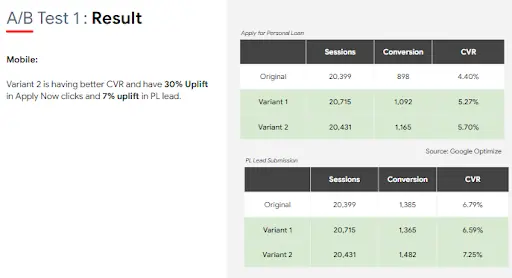
-
Comprehensive Reporting with a Focus on ROI
Ensure that your reports don’t just detail what happened, but also analyze why it happened and its impact on ROI. Use these insights to refine your strategy and make more informed decisions in the future.
-
Iterative Improvement
Treat the process as iterative. Learn from each cycle and continuously refine your strategy, prototypes, and prioritization methods to better align with ROI goals.
Which Conversion Rate Optimization Tools Are Essential for the Success of CRO Strategy?
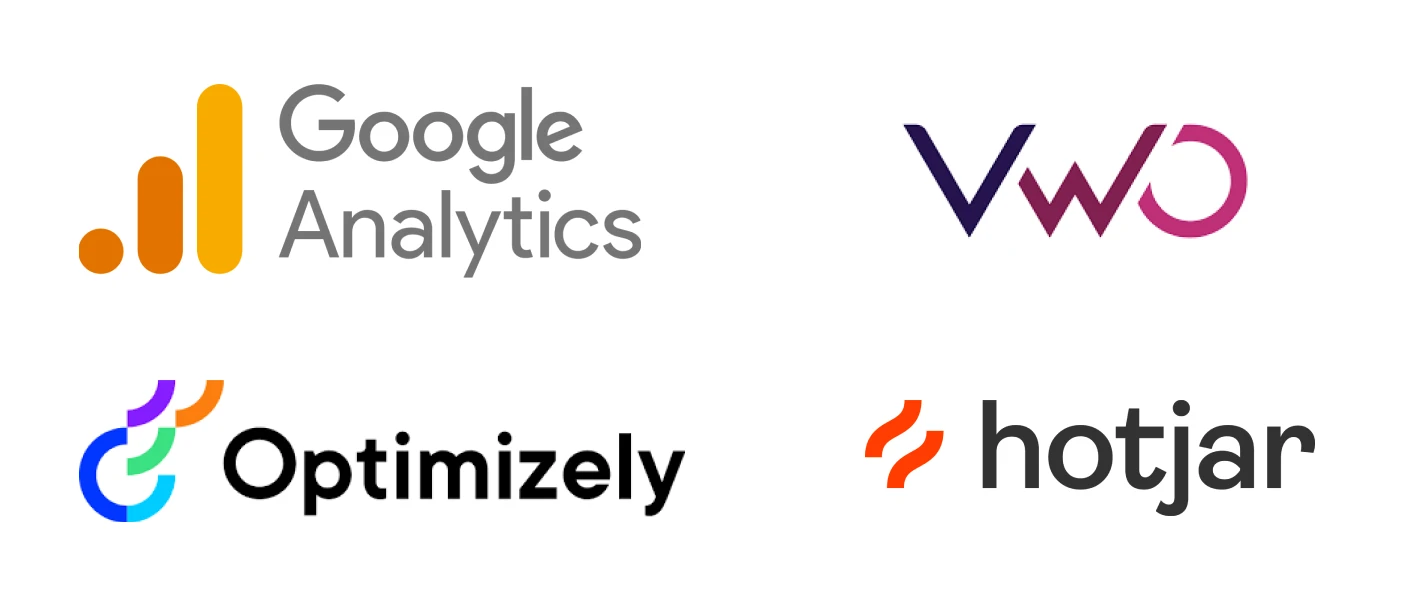
There are many tools available that can help you implement a successful Conversion Rate Optimization program. These include analytics tools, testing tools, and user feedback tools.
1. Google Analytics(GA4):
Google Analytics 4 is a cornerstone for CRO efforts, offering comprehensive insights into website traffic, user behavior, and performance metrics. It enables you to track key performance indicators (KPIs), analyze user journeys, and identify areas for improvement. By understanding how visitors interact with your site, you can make informed decisions, refine your strategies, and align optimizations with user
2. VWO:
VWO is a powerful testing and optimization platform that facilitates A/B testing, split URL testing, and multivariate testing. It allows you to experiment with different versions of your website to determine which elements resonate best with your audience. VWO’s intuitive interface enables you to create and launch experiments, analyze results, and implement data-backed changes, contributing to the iterative improvement of your website’s conversion performance.
3. Optimizely:
Optimizely is a versatile experimentation platform that empowers CRO teams to create and test personalized user experiences. It facilitates experimentation across various elements, including content, layout, and design. By leveraging Optimizely, you can implement changes with confidence, measure their impact, and refine your strategies based on real-time data. This iterative approach ensures that your website evolves in alignment with user preferences and industry trends.
4. Hotjar:
Hotjar is a user feedback and behaviour analytics tool that provides a visual representation of how users interact with your website. Its features include heatmaps, session recordings, surveys, and feedback polls. Hotjar helps you understand user intent, identify pain points in the user journey, and gather qualitative insights. By visualizing user behavior, you can prioritize optimizations that directly address user needs and preferences, leading to a more user-centric and conversion-friendly website.
These tools collectively empower your CRO efforts by offering insights that go beyond mere analytics. They enable data-driven decision-making by providing a holistic view of user interactions, allowing you to identify areas of friction and opportunities for improvement. As seasoned CRO experts, we emphasize the effectiveness of these tools in creating a continuous feedback loop, ensuring that your website adapts to evolving user behaviors and consistently enhances its conversion capabilities over time.
Measuring the Success of Your Conversion Rate Optimization Process
The success of your Conversion Rate Optimization program can be measured in several ways. The most obvious metric is your conversion rate. If your conversion rate is increasing, that’s a clear sign your CRO program is working.
However, there are other important metrics to consider. These include your bounce rate, your average order value, and your customer lifetime value. A successful CRO program should not only increase your conversion rate but also improve these other key metrics.
It’s also important to measure the impact of your CRO program on your overall business goals. This could be increasing revenue, reducing customer acquisition costs, or improving customer satisfaction. Ultimately, the success of your CRO program should be measured in terms of its impact on your bottom line.
5-Rarely-Used Conversion Rate Optimization Techniques for Boosting Conversion Rates:
Many businesses overlook key aspects of CRO that can significantly impact their Return on Investment (ROI). Here are five CRO techniques that are often not executed effectively:
1. The Placement of the CTA and Copy of the CTA:
Common Mistake: Businesses frequently place Calls to Action (CTAs) in less visible areas or use generic copy that doesn’t resonate with the audience.
ROI-Focused Approach: Positioning CTAs strategically where they naturally draw the user’s attention is crucial. The copy should be compelling, action-oriented, and tailored to the specific stage of the customer journey. A/B testing different placements and wording can lead to a noticeable increase in conversions.
2. Adding Benefits Above the Fold:
Common Mistake: Many websites bury key benefits or unique selling propositions deep within the page, making them hard to find.
ROI-Focused Approach: Placing the most compelling benefits above the fold ensures they are immediately visible. This grabs attention and can significantly improve engagement and conversion rates. The message should be clear, concise, and highlight what sets your product or service apart.
3. Incorporating the Principle of Persuasion:
Common Mistake: A lack of persuasive elements like social proof, urgency, authority, or scarcity in the messaging.
ROI-Focused Approach: Employing persuasive techniques can greatly influence decision-making. Testimonials, reviews, certifications, limited-time offers, and displaying limited stock are examples of persuasion principles that can boost conversions when used appropriately.
4. Streamlining the Navigation:
Common Mistake: Overly complex or confusing website navigation can lead to user frustration and increased bounce rates.
ROI-Focused Approach: Simplifying and streamlining the navigation makes it easier for users to find what they are looking for, enhancing the user experience. A clean, intuitive navigation structure can significantly reduce friction, leading to better user engagement and increased conversions.
5. Reducing the Number of Interactive Fields in the Lead Form:
Common Mistake: Long, complicated forms with unnecessary fields often deter users from completing them.
ROI-Focused Approach: Minimizing the number of fields in a lead form to only what’s essential can increase form completion rates. Each additional field is an added step that can cause potential leads to drop off. Simplifying these forms while ensuring they capture vital customer information can greatly enhance lead generation efficiency.
Incorporating these techniques with a focused approach can lead to more effective CRO strategies. It’s not just about implementing these practices; it’s about doing them right. Continuously testing and optimizing based on data-driven insights is key to maximizing ROI in any CRO initiative.
Conclusion
Implementing a robust, ROI-focused Conversion Rate Optimization strategy is no small feat. It requires a deep understanding of your audience, ongoing testing and optimization, and a keen eye on the ever-evolving digital landscape. Yet, with the right tools and strategies, it’s an attainable goal that can transform your website’s performance and significantly boost your bottom line.

